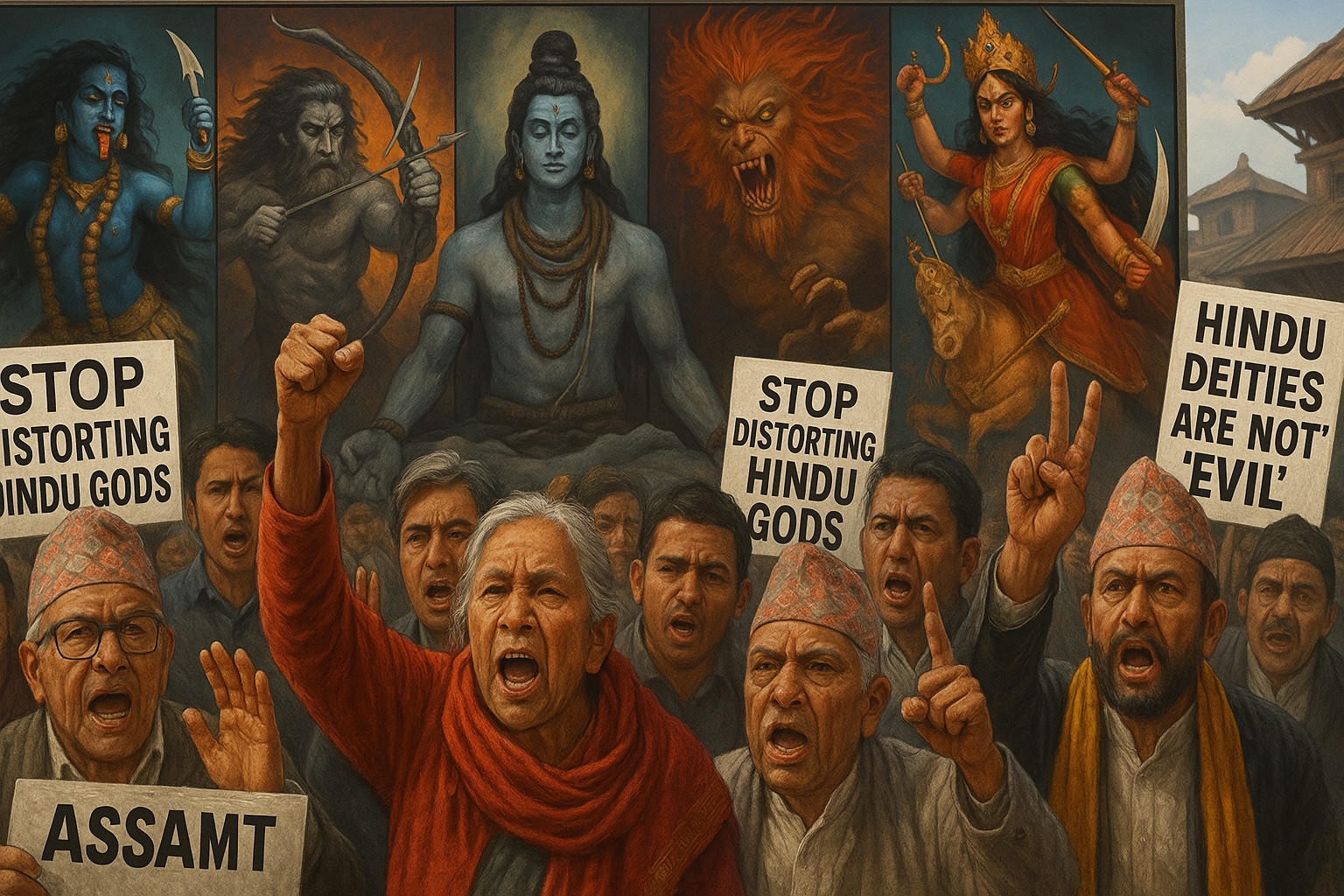Western Portrayals of Shiva and Kali as ‘Evil Gods’ Ignite Cultural Backlash

KATHMANDU — A growing trend in Western film, art, and gaming pop culture to depict powerful Hindu deities such as Shiva, Kali, Narasimha, Bhairava, and Shani as “evil gods” or “dark villains” is sparking intense debate and cultural outrage among Hindu communities. The controversy extends far beyond artistic interpretation — it highlights a deepening clash between Eastern religious identity and Western narrative frameworks, raising questions about cultural representation, religious expression, and the politics of soft power.
Shiva — Lord of Creation and Destruction
Worshipped as a meditative yogi, Shiva is also revered in his fierce Rudra form, whose cosmic Tandava dance symbolizes the end of creation. In his Virabhadra avatar, he is said to have shattered royal arrogance by interrupting a sacrificial ritual. Rituals like the Rudrabhishek are still performed across Nepal and India to appease his power. Yet Western media often depicts him merely as a “destroyer god” — a framing religious scholars have called a “profound cultural distortion.”
Kali — The Vanquisher of Ego and Illusion
Kali is portrayed in Hindu texts as the supreme feminine force that annihilates illusion (maya) and ego — often depicted standing on Shiva, tongue out, garlanded with skulls. According to the Puranas, even Shiva sought refuge to calm her unstoppable fury. But in many Western films and artworks, Kali is rendered as an “evil goddess,” a portrayal that Hindu leaders argue strips away her deep philosophical significance.
Rudra — The Howling Storm
The Rigveda describes Rudra as the “howling god,” whose arrows bring disease and storms but who is also a divine healer. Vedic sages composed hymns to pacify his wrath. Today, tantric practitioners regard Rudra as “raw cosmic power,” embodying both fear and reverence — a complexity often absent in Western renderings.
Narasimha — Avatar of Divine Fury
The half-man, half-lion avatar of Vishnu, Narasimha, is famed for bypassing cosmic loopholes to kill the tyrant Hiranyakashipu — neither by man nor beast, neither inside nor outside, neither by day nor night. His rage was so immense that even the gods were terrified. In Western gaming and art, however, this manifestation is often simplified into a “beast god,” leaving many Hindu observers uneasy.
Durga — Mahishasuramardini, the United Force
Mounted on a lion and wielding multiple weapons, Durga emerged from the combined energy of the gods to defeat the demon Mahishasura. Her victory is celebrated during the nine nights of Dashain. Yet in some pop art and gaming contexts, she is portrayed merely as a “war goddess,” emphasizing violence while ignoring her symbolic role as the embodiment of divine feminine power.
Bhairava — The Fearsome Guardian
Bhairava, a fierce form of Shiva, is considered the invisible guardian of sacred spaces. In Kathmandu’s Durbar Square, officials still take oaths of truth before the stone image of Kal Bhairav. Western portrayals often cast him as a “demonic figure,” drawing accusations of religious insensitivity.
Chamunda — The Blood-Drinking Goddess
Born from Durga’s forehead, Chamunda slew the demons Chanda and Munda, then drank their blood and danced in cremation grounds — a story vividly described in Hindu scriptures. Her idols are placed near cremation sites in Nepal. Western pop culture has commercialized this imagery as that of a “horror goddess,” provoking anger among devotees.
Shani — The Silent Arbiter of Karma
Though not violent, Shani is one of the most feared planetary deities. His dasha (period) is believed to bring prolonged tests, financial challenges, or relationship strains. In South Asia, decisions on marriage, business, and politics often consider Shani’s influence. In contrast, Western narratives sometimes reduce him to a “cursed planet,” a portrayal astrologers deem “ignorant and shallow.”
Growing Cultural Tension
“Hindu deities are not ‘evil.’ Viewing them through a Western lens of villainy is a grave intellectual error,” says Dr. Min Prasad Upadhyay, a religious scholar. “These are not negative figures but fierce expressions of cosmic balance.”
While younger generations experiment with superhero-like or “dark god” reinterpretations on social media, traditionalists warn that the sacred seriousness of these figures is being undermined.
A senior official at Nepal’s Ministry of Culture, speaking on condition of anonymity, noted: “The balance between freedom of expression and religious sensitivity is becoming increasingly delicate.” Nationalist groups have demanded legal action against misrepresentations, while artists defend their work as recontextualization rather than desecration.
As Western pop culture continues to misrepresent or partially depict Hindu deities, the lack of deeper dialogue risks escalating this interpretive conflict — turning what began as artistic reimagining into a simmering cultural fault line.




![From Kathmandu to the World: How Excel Students Are Winning Big [Admission Open]](https://nepalaaja.com/img/70194/medium/excel-college-info-eng-nep-2342.jpg)
